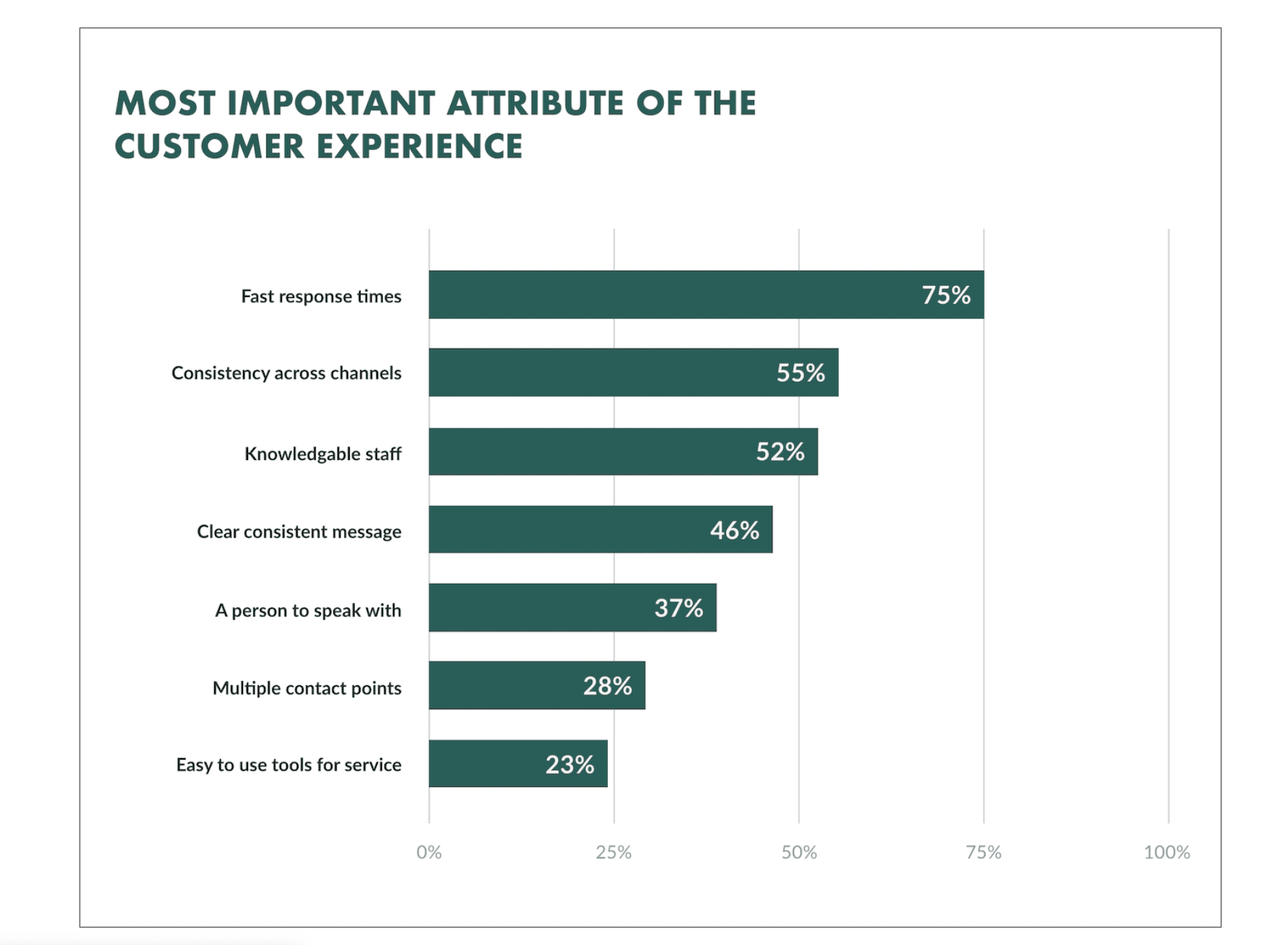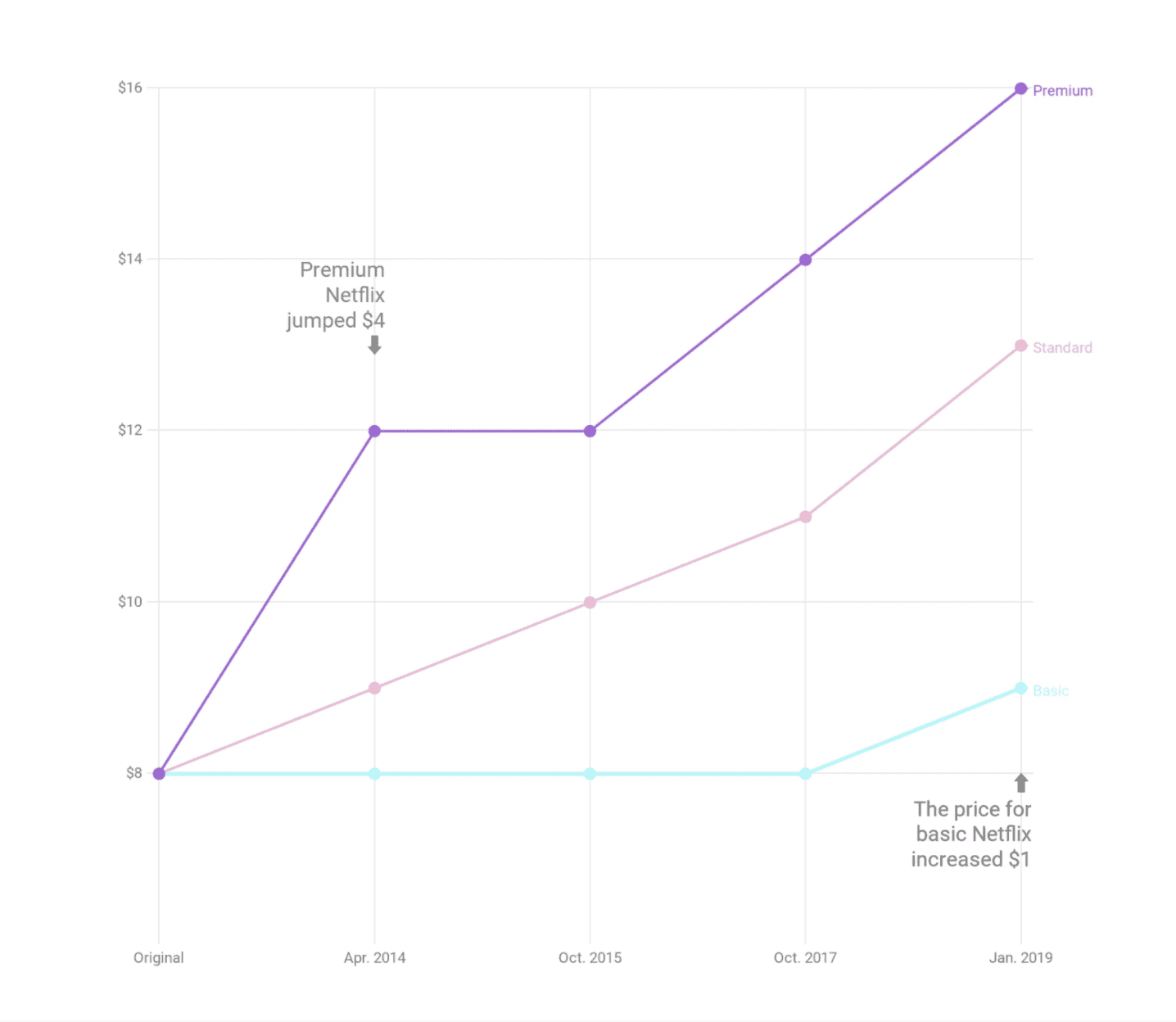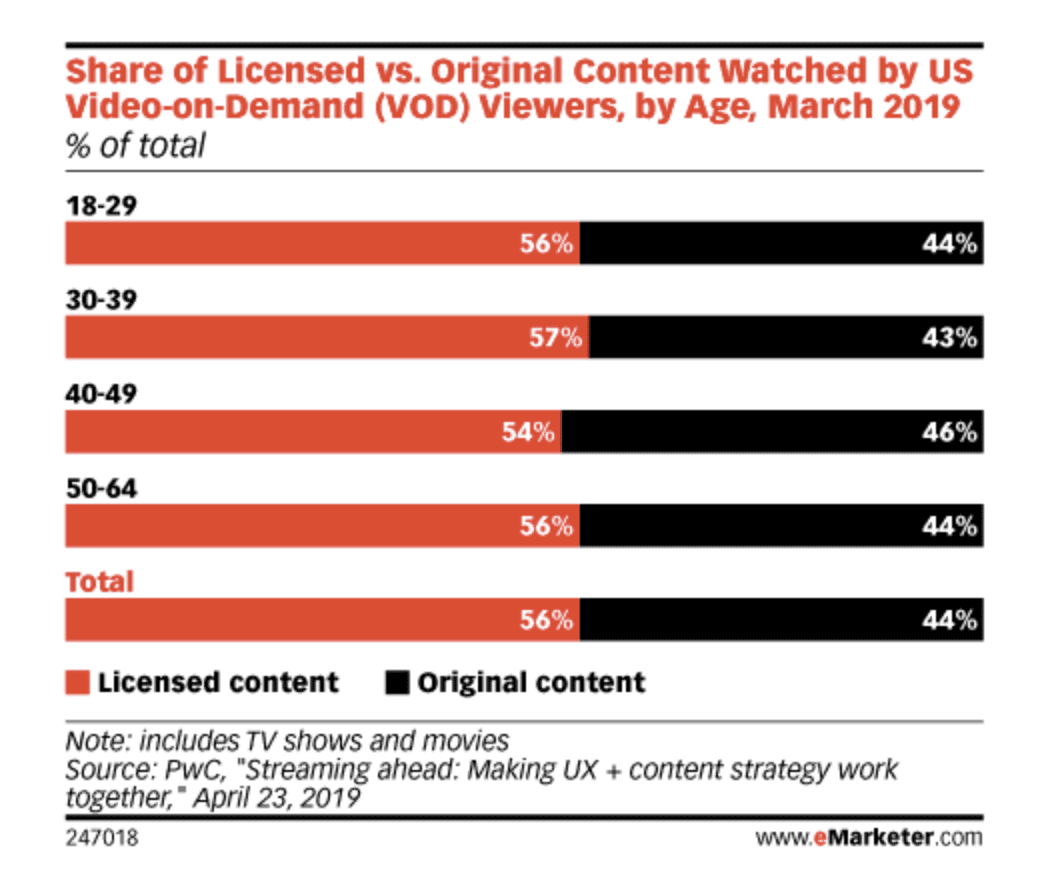Can we all agree that it takes a person with a unique combination of cells and molecules to enjoy long commutes? To avoid the humdrum of commuting, some people sleep, some snack, and some listen to podcasts during this time. But not in the case of these two men.
In the late 90s of California, Reed Hastings and Marc Rudolph, the latter being the CMO and the former being the CEO of Atria, used the time in transit efficiently by coming up with the revolutionary model of Netflix. It would take a couple more years for them to humbly acknowledge DVDs’ shelf life and tweak Netflix’s offering into an SVOD model in 2007.
But a revolution was underway with its roots pushing out anything contrary out of the way (cue Blockbuster filing bankruptcy in 2010).
Fast forward two decades, OTT and streaming media seem to be the only way people consume content. Many households have at least four or five OTT services. Lured by the OTT market’s growth, many ISPs, Telcos, and Operators are joining the fray.
Global projections estimate that the OTT market will be worth $333.52 billion by 2025, growing at a CAGR of 16.7%. Even as these growth figures attract the eyes of more competition, they also indicate the scope available for OTT streaming solutions to drive up revenue. So choosing the right monetization strategy becomes the need of the day.
But before that, let’s look into some standard models of OTT streaming solutions.
Monetization Strategy for Different OTT Streaming Solutions
Advertising Based Video on Demand (AVoD)
AVoD is a powerful monetization strategy and relies on providing free services for the end consumer while driving revenue through ads. We are no strangers to witnessing advertisements on Youtube, and this is the perfect example of the AVoD model in action.
The ads themselves can be custom-made according to the pricing plans. For example, you can place the ads at the beginning, end, or middle. They can be skippable, non-skippable, and so on.
99% of the time, free products are quickly adopted, which helps increase the customer base for the offering. Advertisements help cover the production and hosting charges which help content creators keep their costs to a minimum. In addition, the ads themselves can be customized and targeted based on geography or behavioral points.
The problem with advertisements interspersing free content is that it causes poor user experience in some cases, and you might end up as the butt of many memes that would follow.

SVoD
The number of subscription video on demand (SVoD) subscribers worldwide touched 642 million by the end of 2019. Subscriptions reached 769.8 million in Q3 2020 fuelled by the pandemic, compared to 552.1 million a year earlier, and it is estimated to reach 1.1bn by 2025.

SVoD is a famous model used by many OTT providers such as Amazon, Hulu, Netflix, etc. In this model, viewers can enjoy unlimited content on a subscription basis (monthly, annual, or quarterly). It feels like the real ‘Cut the cord’ movement came upon with the advent of SVoD due to its convenience and low prices.
It is not only convenient for the user and provider, but SVoD is the money-making VoD model. But the overall revenue distribution model is tricky because there are many moving parts. It combines prepaid license fees for content, revenue share based on views, retention rates, etc.
A revenue management platform like Chargebee makes it easier by bringing all this under one roof. You can get a transparent view of the viewer lifecycle and license management across multiple devices.
However, there is a more profound emphasis on security in this model because it houses confidential billing information. And that’s why it is essential to have a billing system compliant with PCI and GDPR.
PVoD
Do you remember that one game everyone toggled for at the arcade during the 90s? Today Mortal Kombat has multiple sequences coming out, and recently its latest part was released irrespective of the lockdown. You could easily access the movie on HBO Max by paying a premium price.
PVoD is like an online movie theater where you pay a premium amount to access any video on demand, unlike SVoD, where you have to wait a couple of months for the movie to be released on the platform officially. The demand for PVoD has increased among the growing tribe of quarantined pajama-wearing folks who have now gotten accustomed to the comfort of watching the latest shows and movies from their couch.
PVoD uses the framework of windowing, where content is released for a window of period and is similar to how movie theaters work. Recently measures have been taken to replicate the SVOD business model and establish a “membership” or “subscription” model within a PVoD model, under which you can watch without concern for costs other than a fixed fee.
Since PVoD is a combination of ads, premium memberships, and one-time pay models, it needs a robust multilevel billing system that can handle the different needs at different levels.
Many popular services also offer a hybrid of all these models and much more.
The Importance of Flexibility
One thing common to companies that have adapted and scaled consistently is the flexibility of their tech stack.
Top OTT player Hulu is very open about the tech stack they use, so much so that their engineering team has a Medium blog where they share constant updates. In early 2007 when Hulu first began, the architecture benefited from monolithic applications written in Rails and jQuery, but as the company scaled, new architectural challenges emerged. They had to bring in a new set of tools to meet their scaling business needs.
The right way to strategize around a tech stack lies in the balance. The technology used should give easy access to control technology stack management, remove unnecessary compatibility issues and empower teams with the best tool for the job at hand, leaving space for automation.
But, what does a winning OTT tech stack look like?
Components of a Winning OTT Tech Stack
Mobile-first Approach
Statista says that US residents spend an average of 323 minutes per week watching video content on mobile phones. With the past decade witnessing more people consuming different forms of content on their mobile, a new window of opportunity has opened up in the world of app monetization. Adopting a mobile-first strategy is essential for all businesses because a growing population is increasingly dependent on their mobiles.
A web page built with a mobile-first design can increase online reach and visibility as consumers directly switch out their desktops to mobile devices. Be it an app that can be downloaded or has a mobile-friendly webpage, it increases your customers’ chance to share your products and services with their peers via social media and messaging platforms through their smartphones.
While opting for a mobile-first design, it is crucial to set workflows and goals for them, and you can layer the desktop design with application design based on those workflow and plans. If your organization focuses on DevOps, then it’s easier to streamline the deployment process for your platform’s mobile and desktop variants.
Testing and monitoring can provide feedback on how to improve your application or website. To have your OTT service either as a mobile-first offering or as an app can be tricky because you need to consistently offer an impeccable customer experience besides tracking and gauging transaction behavior. You also need to have the proper revenue analytics tools to help drive the company in the right direction.
At Chargebee, we have enabled scalable subscription revenue for over 18000 businesses spread across 50 countries and help with all the above. In addition to that, we also take care of managing your products, payments, and revenue reconciliation across channels. By automating repetitive functions, you can focus on essential areas of optimizing app performance, user experience, and feature releases.
Tech Stack that Supports Changing Content
Today’s customers are very picky with what they watch. Now, nobody wants to repeat a Game of Thrones Season 8 situation or wait for a new show to release for years. With the amount of content out there, people would quickly migrate at the slightest slack from your OTT platform.
The business of content creation is very slow in adapting to technological changes. Many famous OTT platforms get involved in original content creation to tackle delays when customers start falling through. There is also an increasing demand for original content, as seen below.
Adding and removing content on the go is very important, and your tech stack should accommodate it. Today we have middleware providers like Setplex or AlphaOTT teaming with content delivery networks like Amazon Cloudfront and Akamai to help manage content more efficiently.
Self-serve
Nobody wants to speak to a salesperson before pressing play on the show they have waited to watch all week. Most OTT platforms rely on product-led growth supported by an efficient self-serve model. It works well in the OTT landscape as the customer needs to be in the driver’s seat.

It comes as no surprise that the above chart from SuperOffice shows that customers respect a fast response time and call it a joyous experience if they can access things when they want it without much delay. The Chargebee Self-Serve Portal allows your end customers to manage their accounts and subscriptions by themselves. Also, Chargebee’s self-serve portal can be opened inside your app rather than redirecting to a different page.
One of the other advantages of running a self-serve OTT is that there is scope for real-time optimization and proactive management in driving and controlling strategy. Getting the most out of self-service DSP/OTT requires careful management of your systems. Partnering with a billing platform that understands your program and self-service DSP would help you gain control using self-service.
Product Catalog+Archive/ Unarchive Plans
The below chart that appeared in Recode shows how the pricing of Netflix’s services changed throughout history. The change in pricing is usually justified with new content and new channels to the existing multi-channel system.

Your revenue system faces the brunt of it if it doesn’t catch up with the changes. With Chargebee, you can choose to archive or unarchive your pricing plans; this becomes extremely useful when you wish to delete a plan or grandfather users. With Chargebee’s Product Catalog 2.0, you can manage your content in the pricing catalog, price premium content as add-ons, and model your pricing catalog in any way as you add more .content. It also helps you streamline multi-product offerings with any additional code, thus saving more time.
Speed Test and User Experience
When you see the constant changes in OTT platforms, you can see that everyone is just winging it to an extent, even the well-established ones. The best strategies often come from just winging it. But the key is to analyze what works and be quick to optimize it. An OTT platform’s fundamental experiments can run on its homepage, recommendation algorithm, log-in flows, and ads.
By experimenting with new pricing and delivery models, you can unearth several new growth opportunities. By exploring payment terms, offering freemium plans, or tiered subscriptions, you can quickly ramp up your subscriber list.
At Chargebee, we have the highly coveted Time Machine.
It is a simulation feature that allows you to test the billing configurations in Chargebee. You can test features such as dunning, consolidated invoicing, subscription states, scheduled subscription actions, webhooks, etc., by virtually traveling through time to check how your subscriptions, dunning settings, invoicing, etc. work.
Simply put, the Time Machine allows you to foresee the status of your subscriptions and the changes they are subject to under various scenarios. This allows you to understand and verify how the billing rules configured in your test site would work in real-time.
Global Expansion
Owing to the rapid pace of the OTT market and the adoption of 4G and 5G networks, there is more scope for video and audio streaming platforms to expand into new markets.
The Asia-Pacific region is expected to undergo the fastest growth at 20.8% CAGR. The main reason is that the telecom providers in these areas now offer OTT services with their data plans. Over the next five years, the US, the largest market, is estimated to grow at a CAGR of 11.22%, while Europe is expected to clock a growth rate of 13.5%.
So today, any company can expand at the click of a button if it has a leak-proof revenue system and understands the various compliance requirements of each country. Voitek Sobieszczanski, VP of Finance, Study.com that scaled painlessly to millions of users and more geographies vouched for scaling with an efficient system like Chargebee by saying,
“With Chargebee, subscription billing and management is automated and optimized, so you can charge ahead to growth and let Chargebee do all the things you don’t want to do, like reconciliation. For instance, instead of spending hours trapped between mountains of data, manually matching transactions between our bank statements and accounting software, Chargebee bridged the gap by automatically importing transactions from our payment gateway into our accounting software, letting us reconcile with just one click.”
Promotion
Promotion plays a key role when it comes to the acquisition and retention of users. Being proactive and keeping your messages highly personalized throughout your customer lifecycle would help match promotions with where it is needed.
By deploying accurate reporting that billing systems like Chargebee offer, you can dig deeper into customer preferences and usage trends. When the customers are at risk of churn, reengage using discounts. If your customer has canceled their subscription, then run a proactive campaign to those users with specific personalized offers to reiterate the product’s value. For loyal customers, go the extra mile and offer rewards. Chargebee gives you the flexibility and ease of providing buyers with discounts, promotions, and special offers with coupons.
Another critical area of monetization lies in affiliate integrations. Affiliates make one-time or recurring commissions. Also, advertisers can use pay-per-lead via free trials and account sign-ups. Here’s an example of Apple’s affiliate program.
Chargebee makes monetization from tools easier as they have ready-made integration with some of the most prominent affiliate providers. This makes the work of the operators secure and seamless in generating more revenue. The access to third-party integrations set many OTT services teaming with Chargebee apart.
Lastly, focus predominantly on the user. An extraordinary user experience goes a long way in keeping customers happy and improving customer retention. So use data-based recommendations to personalize what your customers should view next proactively. Keep track of how often playback is interrupted and the average bit rate per session. Remember to deliver a clear picture to your users, as you want to ensure their long-term satisfaction and maximize their LTV (Lifetime Value).
The Importance of Controlling Churn
The good news about churn in OTT is that, in research conducted by Park Associates, the churn rate has dropped from 46% in Q3 2019 compared to 38% in Q3 2020 due to the stay-at-home rules. While quarantine won’t last forever, this was the momentum the OTT market needed to scale. While the top 3 players (Netflix, Amazon, and Hulu) are experiencing churn, lesser than the overall average, new and small players continue facing its brunt.
But to make up for the lack of resources or capital, the new players can always manage by taping the leaking bucket of revenue. Involuntary churn, which makes up most of the leaking bucket, bites away a larger chunk of revenue.
With Chargebee’s smart dunning sytem you would be able to send customized reminders for repayment of overdue bills. The smart logic behind this form of revenue recovery allows you to improve your retention rate and help avoid getting blacklisted by any gateway.
Tackling Credential Abuse
In a conversation with Nick Ntigrintakis, the CEO of Alpha OTT, he gave away his strategy on facing credential abuse.
He acknowledges that it is challenging to limit the subscriber with IP, and also, if one is too hard on the security, they might lose the subscriber. He suggests the best way would be to top users per household and not per subscriber. To maintain a balance between security and revenue from the tech side, most people in the industry offer one to three devices per account.
Thankfully. Alpha OTT is our solution partner and they help curb the issue of credential abuse with their range of services
While tools that help in monetization are essential, the option to experiment with different monetization models is even more critical. Integrating Chargebee into an existing ecosystem would allow in setting up the various monetization models. Right from sign-up with a free trial without a credit card to sign-up with a voucher or a coupon to use the service for X days, Chargebee gives you all the flexibility to launch fast and successfully.
If you’d like to understand more about monetizing your OTT platform, get on a call with us now.


